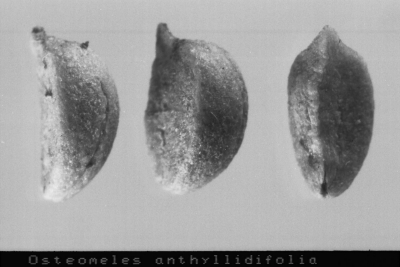 Hawaiian Name(s): ‘ūlei, u‘ulei, eluehe (Molokai)
Hawaiian Name(s): ‘ūlei, u‘ulei, eluehe (Molokai)Scientific Name: Osteomeles anthyllidifolia
Vernacular Name: none
Family: Rosaceae
Status: indigenous
Authority: (Sm.) Lindl.
Description: Shrubs; glossy green leaves with white fragrant blossoms and round fruit.
Habitat Occuring in a wide variety of habits including dry open shrubland, dry to mesic forest, disturbed sites, lava fields; between 2–2320 m on most main islands (Wagner et al. 1990:1104–1105).
Medicines: To treat ‘ea and pa‘ao‘ao, the leaf buds and seeds ‘ūlei are eaten until the illnesses are gone. To treat open cuts or injuries, the ‘ūlei bark , leaves, and salt are pounded into a mass and applied to the cut (kahi ‘eha) (Chun 1994:250–251).
Non Medicinal Uses: Mature, hard wood used for oo (digging sticks) (Krauss 1993:25), musical instrument: ukeke, musical bow (Krauss 1993:85); short spears, including octopus spears (Kamakau 1976:70) and ihe pahee (javelin) (Malo 1951:22); younger, flexible branches for fish net loops (Malo 1951:22); fruits as famine or casual food, lavendar dye & lei (Krauss 1993:16,67,77).
Specific gravity of wood: unknown
Famous Locations:
Mele:
`Ōlelo Noeau: [I] ‘A‘ole i ‘ena‘ena ka imu i ka māmane, me ka ‘ūlei, I ‘ena‘ena i ka la ‘ola‘o. The imu is not heated by māmane, and ‘ūlei wood alone, but also by the kindling. To be powerful, a ruler must have the loyalty of the common people, as well as the chiefs. [II] He ‘ūlei kolo. A creeping ‘ūlei. An expression applied to a tough, strong person. The wood of the ‘ūlei is very strong and was used as a fishing spear in older times.
Dye Color and Parts: Lavender (fruit)
Kino lau:
Location on Bishop Museum Kalihi Campus: In courtyard
Propagation Information: From seeds: separate pulp from seeds in water and soak for a day or 2, seeds are small so sow carefully on moist, prefirmed pot medium. Or from cutting: cut 2–4 inch stems, use rooting hormones and keep moist in 1st wks. Like lots of sun, water and well-drained soil (Bornhorst 1996:31–32; Nagata 1992:1993 addendum).
Hawaiian Native Plant Propagation Database.
Native Plants Hawaii.
Seed: Seed length approximately 4 mm. Photograph: B.Kennedy.

